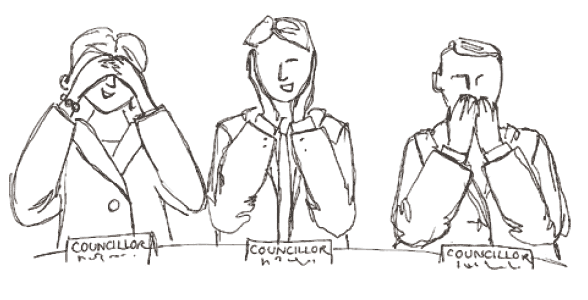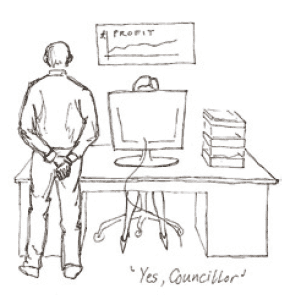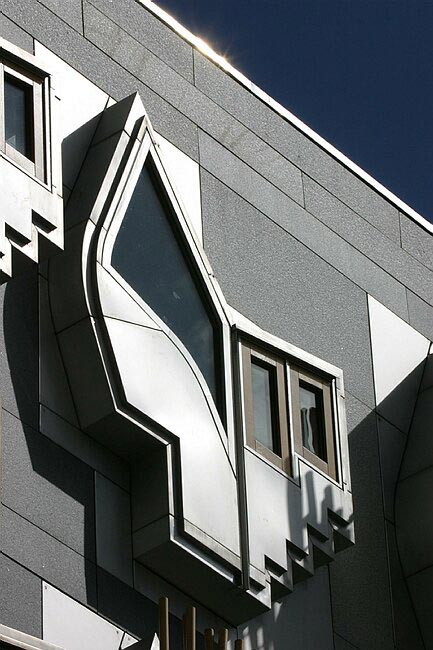Oor Destroyed Hoosis
An illustrated essay by Sarah Glynn originally for the Derby Street Multis Residents’ Association to help people learn what has happened to ‘oor hoosis’ and to similar houses almost everywhere
This story begins around 40 years ago, when many people across Britain lived in crowded decaying slums. Councils were knocking down the slums and building millions of new homes to rent. Conditions were improving for millions of families. Public money was being used to subsidise the new homes. Councils were boasting about how many homes they had built. In Dundee’s Hilltown, people protested over leaving their old homes and communities. But after the new multistorey blocks were built in Derby Street there were queues for a place in the 374 flats.
When the Derby Street multis were less than ten years old, Margaret Thatcher became Prime Minister. She wanted as many things as possible to be bought and sold for private profit. She didn’t want publiclyowned houses to provide good cheap homes and a fairer society. She didn’t even believe in society. She wanted more people to buy their homes and work to improve their own individual families. And she knew that people who had borrowed money to buy their homes would find it difficult to go on strike. Councils stopped boasting about how much housing they had. They began to get rid of their homes. When Margaret Thatcher left Downing Street, her ideas stayed behind – even when Labour came back into government. Most of the nicest homes were sold. Many of the others were knocked down. Councils weren’t allowed to spend much money on looking after their homes and some of these homes started to become new slums. Council houses had provided homes for half the families in Scotland. They had housed whole communities of people who did lots of different kinds of jobs. Under Margaret Thatcher and the prime ministers who came after her, industries were shut down and many of these jobs disappeared. Communities fell apart. The remaining council houses became homes of last resort for the poor.
Seven years ago, a group of academics was asked to show just how few council houses Scotland needed. They produced lots of big equations, but they said that noone should have a council house if they could scrape together the rent for a privately owned flat.
And they said that people who needed a council house now, could wait for up to ten years. By saying that most people who wanted a council house shouldn’t get one, they argued that some Scottish councils needed to get rid of lots more of their homes.
Dundee City Council looked at the report written by the academics and decided to demolish 2,000 more homes, including the Derby Street multis. They said that people didn’t like living in the multis. Derby Street tenants made a survey of their neighbours. They found that seven out of every 10 people wanted to stay in their homes. Less than one in 10 thought the buildings should be demolished.
For a long time, very little money had been spent on council housing. Now the houses were looking sad. The government said they must be improved; but they gave no money to pay for this. Some councils decided it was easier to pull down homes than improve them. Dundee City Council said that they had to pull down the Derby Street multis to save the money needed to improve their other homes.
When the Council decided to demolish these homes they quoted a report. Tenants asked to see the report. The council said ‘no’. Tenants asked the Scottish Information Commissioner. He told the council that the Freedom of Information Act said that they had to show the tenants the report. The report said that demolishing the homes was much more expensive than keeping them. Tenants told the newspapers everything they had learnt. The Council just said: we are demolishing homes that weren’t needed and that weren’t liked and this will save money.
The council said that they would sell the land to a developer. The developer would build new houses for people to buy and sell. This would make Dundee a better place for richer people to live. But they didn’t say where poorer people would go.
All over the world houses were being bought and sold to make money. Big banks borrowed huge amounts of money and used it to gamble that house prices would go on rising for ever. When house prices fell the banks lost huge amounts of money. Lots of people lost their jobs. Governments gave huge amounts of money to the banks.
More people lost their jobs. People stopped building so many houses to buy and sell. More people wanted good cheap houses to rent. But most council houses had been sold or destroyed.
Last year different councillors began to run Dundee Council. They said that perhaps the Council should keep the Derby Street multis. The council officers, who work for the Council, weren’t happy. They didn’t want to change their plans. They said that improving the buildings was too expensive. The tenants asked a big building company what it would cost. They said that they could improve five flats for the cost of building one new house. But the council officers said the Council didn’t have enough money. The tenants asked a housing association if they would buy and improve the multis. The housing association wanted to make an agreement with the Council. But the council officers said no. And the councillors, who are in charge of the Council, did what the council officers told them.
And that is how Dundee destroyed good houses, people were forced to leave their homes, more communities were broken up, local shops were left without customers, poorer people were moved out from the centre to the edge of the city, more people had to pay higher rents, the council lost millions of pounds of rent money and had to pay millions of pounds for demolition and the housing waiting list kept getting longer.












